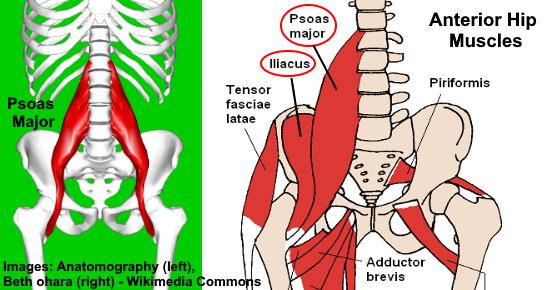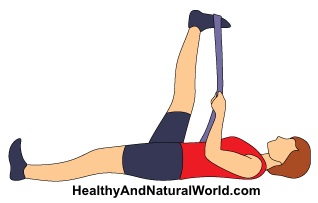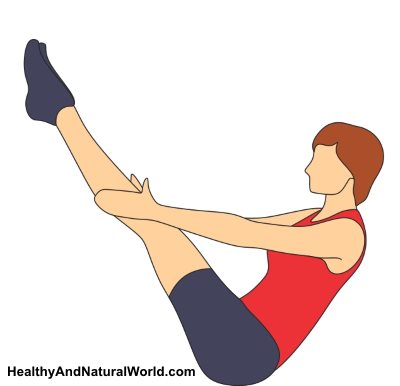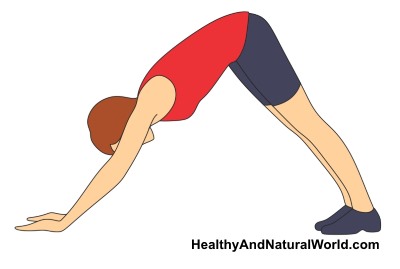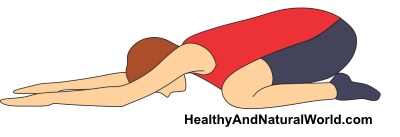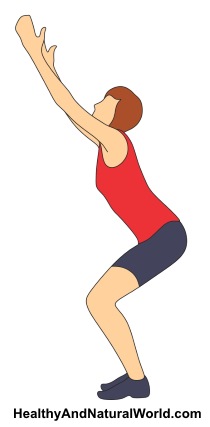The Psoas Muscle and How to Release it to Relieve Pain and Tension
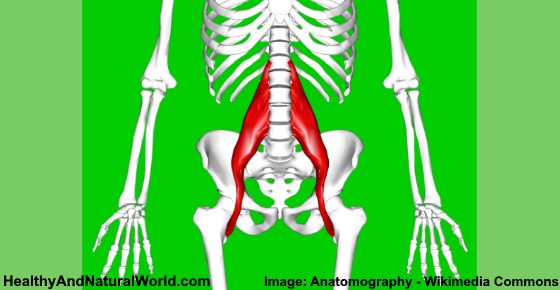
The psoas muscle is an important muscle located in your lower back or lumbar region. Tension in the psoas muscle or injury to it can be a cause of low back pain and discomfort. Knowing how to release the psoas muscle is one of the ways to ease back pain and tension. However, the muscle is deep within your core and it’s not always easy to stretch or exercise the psoas muscle.
Usually, the best way to relieve pain and tension in your psoas is to perform various stretching exercises. Stretching your back, spine, and your leg muscles can help to release a tight psoas muscle and ease lower back pain. In some cases, physical therapy with a specialist is needed to release the muscle and relieve tension.
In this article, I will look at what exactly the psoas muscle does and the important role it has in your core muscles. If you suffer from lumbar pain, then you will find helpful stretching exercises for psoas muscle pain and tension relief.
What is the Psoas Muscle?
The psoas muscle connects your upper body with your legs and is one of the important muscles in your core.
According to MedicineNet: “There are two psoas muscles on each side of the back. The larger of the two is called the psoas major and the smaller the psoas minor. The psoas major originates at the spine around the bottom of the rib cage and runs down to the thigh bone (the femur). The psoas minor also originates at the spine around the bottom of the rib cage but it runs down to the bony pelvis. It acts to flex the lower (lumbar) spine.”
The Journal of the American Osteopathic Association says that the psoas muscles attache to your vertebrae in your thoracic spine and lumbar region. These are the only muscles in your body that attach your legs to your spine. The psoas muscle is important because it allows you to bend your legs forward – for example, when running, walking, or going upstairs.1
The psoas major muscle connects with the iliacus muscle which is located in your hip bone. Together they both form the iliopsoas muscle. There are also nerves and ligaments that connect to your psoas and iliacus muscles.1
What the Psoas Muscle Does
The main function of the psoas muscle is to give your body stability, strength, and help keep your balance.
According to the Journal of the Canadian Chiropractic Association, the psoas major muscle is mainly used to flex the hip joint. It is also the major muscle that flexes and stabilizes the lumbar spine and provides strength to your lower back.2 The psoas minor acts to flex the lower (lumbar) spine helping you bend forward.
Anytime you walk, run, bend over to pick something up, or even stand still, your psoas muscles help to stabilize you.
It’s important to release psoas muscle pain naturally because you can end up with more aches and chronic back and leg pain. If you have muscle imbalances, you tend to overuse other muscles to compensate for the pain. This can lead to strained or torn muscles in your middle back, legs, or other areas of your body.
Symptoms of Psoas Muscle Pain or Strain
Psoas muscle pain is often referred to as psoas syndrome, and the most common symptom of psoas muscle strain is lower back pain. The Journal of the Canadian Chiropractic Association commented that pain in the lower back can feel sharp and jabbing and may get worse if you put extra weight on your right or left leg.2
Pain from tight or tense psoas muscles may also radiate to other parts of your body. For example, the Journal of the American Osteopathic Association reported that pain can often start in the lumbar spine area and spread down one or both legs to the knee. Tension in your core muscles like the psoas muscles can also make it difficult to stand straight upright, and you may also experience pain in the buttocks or hips.1
There are also symptoms of psoas pain that are related to your internal organs. For example, appendicitis or kidney stones can cause irritation of the psoas muscle. Also, psoas muscle syndrome can affect your breathing because psoas muscle dysfunction can also affect your diaphragm.1
Psoas muscle pain and tension can cause back pain and difficulty standing up, especially if you have been sitting for long periods of time.
Doctors from the Cleveland Clinic say that other symptoms of a tight psoas muscle can include:3
- Lumbar pain when you move position after sitting for lengthy periods of time
- Pain when standing erect
- Pain that radiates to your buttocks or down one or both legs
- Groin or pelvic pain
- Walking with a limp or finding it difficult to lift your feet when walking
Of course, there can be many other reasons for low back pain. For example, kidney stones, gallstones, sciatic pain, IBS, or prostatitis (in men), can all be reasons for aching discomfort in your lower back.
Back Pain and the Psoas Muscle
Back pain caused by weak or injured psoas muscles can be debilitating and affect your general feeling of well-being.
There are many reasons why psoas muscle dysfunction can lead to back pain and other associated symptoms. According to the European Spine Journal, not using your muscles enough can lead to weak muscles. So, sitting for long periods of time means that your psoas muscles are always in a flexed state. This can result in tight psoas muscles.4
The European Spine Journal also noted that herniated spinal discs can be another reason for low back pain that is connected to the psoas muscles. Usually, patients with spinal dysfunction restrict movement in their lower back, which leads to the psoas muscles being tight and in a constant shortened state.4
This can lead to the formation of myofascial trigger points also knows as trigger points. According to the trigger point model, unexplained pain frequently radiates from these points of local tenderness to broader areas, sometimes distant from the trigger point itself.
The journal Current Pain and Headache Reports explained that overusing muscles or muscle injury can cause tender points in hardened bands of muscle. Trigger points cause referred pain to other areas of your body and can be a reason for acute or chronic pain spreading from your lower back.
Trigger points can feel like knots, and it’s important to stretch the muscle properly to release the tension and pain caused by trigger points. Doctors say that this helps to increase blood circulation to the affected area and helps speed up the healing process.
According to the Journal of Manual and Manipulative Therapy, some of the sensations that trigger points can cause are:5
- Tingling in other parts of your body
- Numbness in a limb
- Referred pain that spreads from the tight muscle
How to Release a Tight Psoas Muscle
Because the psoas muscle is located deep in your core, it can be a challenge to release a tight psoas muscle to relieve pain and backaches.
The Journal of the American Osteopathic Association recommends various forms of physical therapy to help treat psoas syndrome. Various stretching exercises help to strengthen the core muscles and can release psoas muscle tension. The doctors recommended some of the following techniques to improve the symptoms of psoas muscle pain:
- Stretching the psoas muscle to relieve pain and tightness. Various stretches like lunge stretches help to exercise and stretch the muscles in your groin and pelvic area.
- Yoga stretches for psoas muscle release. In a similar way, certain yoga stretches are effective for releasing a tight psoas muscle. They can help to stretch your spine and lower back muscles.
- Releasing the psoas muscle with massage. In some cases, massage is needed to release trigger points on a tight psoas muscle to alleviate referred pain and other symptoms.
How to Stretch the Psoas Muscle
Stretching the psoas muscle is possible by performing leg stretches on your hamstrings. These types of stretches help to increase flexibility in your psoas muscles and lengthens them to prevent them from becoming tight and constricted.
Reclining big toe pose
The reclining big toe pose is one of the best ways to release tension and pain in your psoas muscle. This is a good exercise if you have chronic lower back pain as it doesn’t put any strain on your lumbar region.
How to perform the reclining big toe pose for lower back pain relief:
- Bring your right knee close to your chest.
- Take an elastic strap and put if over the ball of your foot and hold the ends of the strap.
- Straighten your right leg and stretch it up towards the ceiling, keeping your foot flexed. (Make sure that both buttocks are firmly pressed against the floor).
- Hold for 10 breaths.
- Gently bend your knee towards your chest and lower your right leg to the floor.
- Repeat with your left leg.
Yoga Stretches to Release the Psoas Muscle
Many yoga stretches are perfect for releasing tension and pain from your psoas muscle. When performed on a regular basis, these yoga stretches can help manage the symptoms of acute and chronic low back pain. They will help to improve muscle tone and improve your overall feeling of well-being.
Boat pose
The first yoga stretch we will look at to release tension and tightness in your psoas muscle is the boat pose. This is an excellent stretch to release a tight or overstretched psoas muscle.
This exercise helps to strengthen your core and build stamina in the psoas muscles. Because of the extra strength in your core, the boat pose will help you maintain better balance.
The main focus of the boat pose in strengthening your psoas muscle is to keep your spine straight while trying to straighten your legs.
How to do the boat pose to release psoas muscle tightness:
- Sit on the floor with your feet flat on the floor and your knees bent.
- Keeping your knees bent, lift your feet off the floor.
- Slowly extend your legs so that your shins are parallel to the floor.
- At this point, your upper body will naturally fall back. However, it’s important to keep your spine straight.
- Keeping your spine straight, straighten your legs to a 45-degree angle. Your body should now be in a “V” shape.
- Straighten your arms and roll your shoulders back and hold your arms parallel to the floor.
- Balance on your sit bones and hold your position for at least 5 breaths.
Downward facing dog
The downward facing dog pose is excellent yoga stretch to release the psoas muscle. This exercise helps to improve stability and strength in your psoas muscle and lower back.
The downward facing dog pose helps to flex your spine at the places where the psoas muscles are joined. It also stretches the hamstrings to really help increase the range of motion in your pelvis and lumbar muscles as well as stretching your legs.
How to do the downward facing dog to strengthen psoas muscles:
- Start on your hands and knees.
- Your wrists should be directly below your shoulders and your knees below your hips.
- Breathe out as you gently lift your knees off the floor until your legs are straight.
- Your body should be in the shape of an “A”.
- Try to stretch your pelvis up to the ceiling and lengthen your spine.
- Make sure there is equal pressure through your heels and palms.
- Now, try to draw your shoulder blades into your ribs and toward your tailbone.
- Rotate your arms so that your thumbs are pointing in front of you.
- Hold for at least 5 breaths.
- As you return to the starting position, exhale slowly.
Child’s pose
The child’s pose is a popular yoga stretch to engage your psoas muscles and increase strength in your lumbar region. This helps to lengthen your spine as well as stretching your hips and relaxing your whole body.
How to perform the child’s pose to alleviate tension and tightness in your psoas muscle:
- Take up a kneeling position and have your heels directly under your buttocks. Your big toes should be touching.
- Lean your upper body forward and place your arms straight in front of you.
- Your forehead should touch the ground.
- Breathe in deeply 10 times making sure that your rib cage expands and contracts.
Chair pose
The chair pose is a great yoga technique to strengthen your psoas muscles and also increase strength and flexibility in your lower back. You will find that the more you practice this yoga pose, the easier it becomes. The result should be that you will have less lower back pain and stiffness.
The chair pose helps to strengthen your abdominal muscles, lower back, thighs, and glutes.
How to do the chair pose to release the psoas muscle:
- Stand straight with your shoulders back.
- Lift your arms above your head and turn your palms so they are facing each other.
- Bend at the knees and let your pelvis drop as if you were about to sit down.
- Hold for 5-10 breaths and then return to the starting position.
Massaging the Psoas Major and Iliacus (Iliopsoas) Muscles to Relieve Tension
One way to help release your psoas muscles and ease lower back pain is to massage the psoas major and iliacus muscles. This helps to get rid of trigger points that can be causing referred pain and also helps to ease muscle tension.
However, for an untrained person, it can be a challenge to locate the exact location of the psoas muscle. There are also many important organs in your abdominal area and you could damage one of them if you start massaging or pressing on the wrong place.
To help release tension in your lower back, you can perform a gentle self-massage on your abdomen. The best way to do this is to use a roller ball or tennis ball. Your psoas muscles are located about 2 inches on either side of your belly button. Gently press the tennis ball into your abdomen and run it in a straight line towards your pelvis and back again.
Read my other related articles:
- How to Use Tennis Ball to Relieve Sciatic Pain and Back Pain
- Effective Treatments for Pulled, Strained or Torn Back Muscle
- The Best Yoga Stretches To Soothe Your Back Pain
Article Sources

